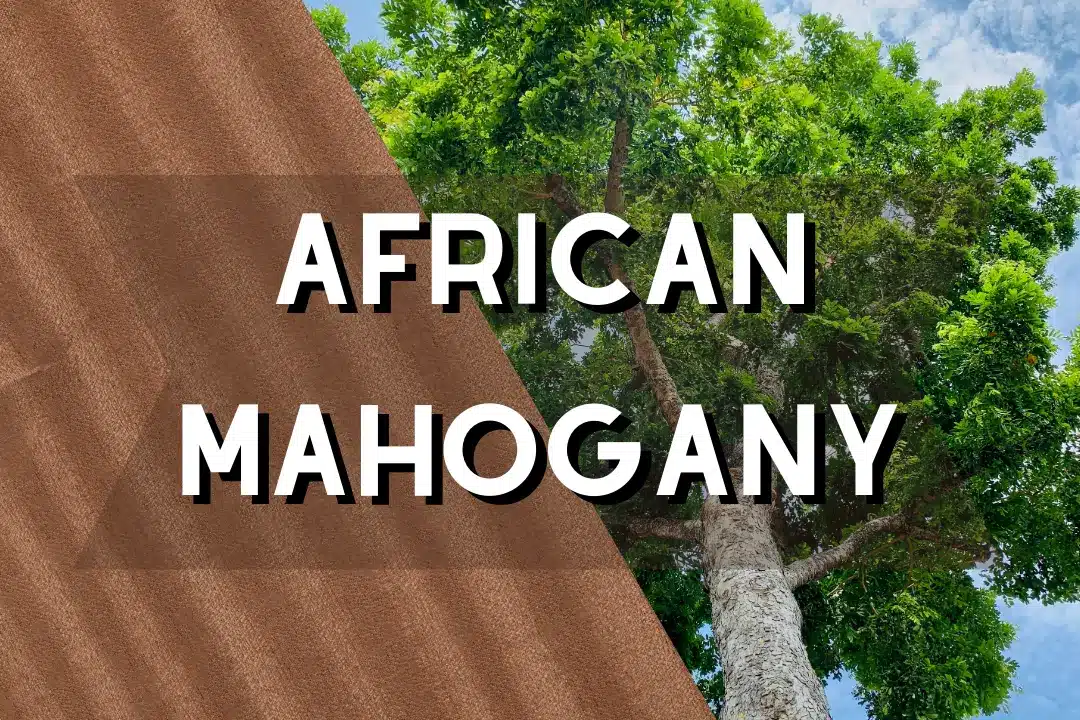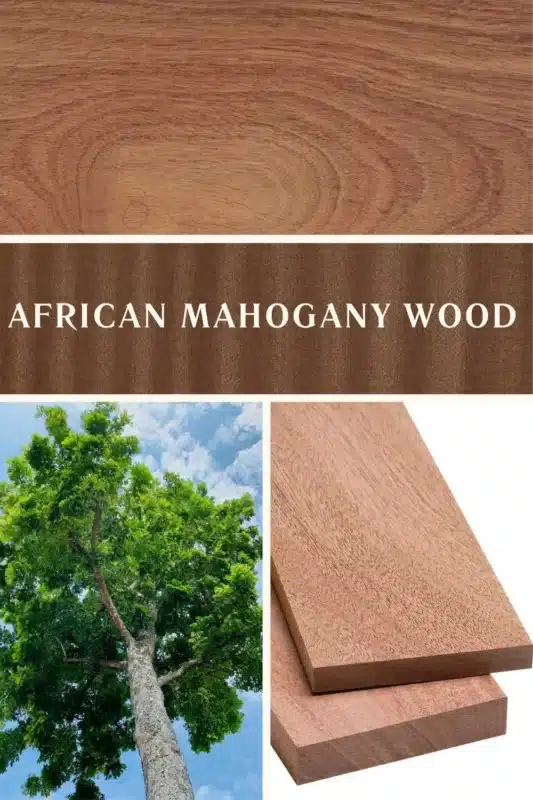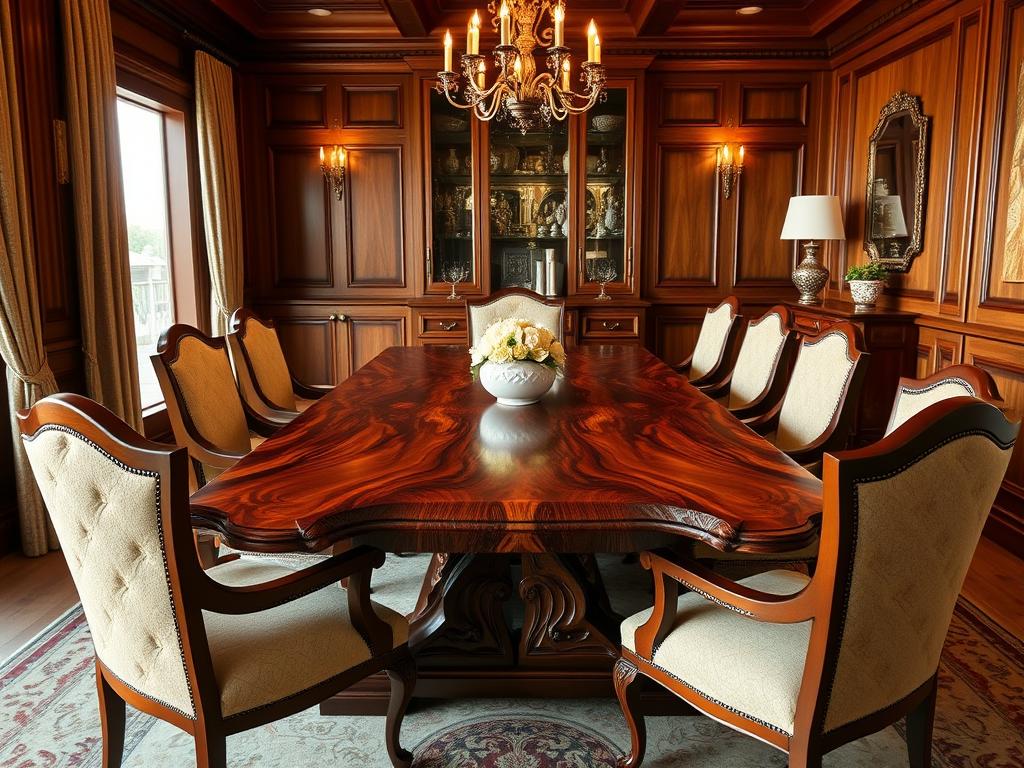
The Ultimate Guide to African Mahogany Wood: Properties, Uses, and Benefits

Did you know that about 80% of African mahogany wood goes into making high-end furniture? This shows how much people love this premium wood. It’s known for being tough and looking amazing, making it a top pick for woodworkers and designers.
African mahogany comes mainly from West and Central Africa. It’s famous for its beautiful reddish-brown color and special qualities. This wood is perfect for many things, like fancy furniture and musical instruments. As we look into mahogany’s properties, uses, and benefits, you’ll see why it’s more than just wood. It’s a symbol of quality craftsmanship.
Table of Contents
What Is African Mahogany?
African mahogany is a term for several tree species in the Khaya genus. The main ones are Khaya ivorensis and Khaya anthotheca. These trees grow tall, reaching 100 to 200 feet, and have trunks up to 6 feet wide. Their wood ranges from pale pink to deep reddish-brown, making it beautiful.
This wood is prized for woodworking and construction. Its unique look and durability make it stand out.
Species Classification
African mahogany includes different Khaya trees, each with its own features. Some notable ones are:
These species vary in density and color. This variety makes African mahogany useful for many projects.
Geographic Origin
This richly colored wood comes from tropical Africa. Countries like Ghana and the Democratic Republic of the Congo are major sources. The wood is harvested sustainably to protect the forests.
Historical Significance
African mahogany has a rich history. It became popular after South American mahogany was restricted in 2003. This made African mahogany a cost-effective choice in the U.S.
Its affordability without sacrificing quality has boosted demand. This wood is now a favorite among woodworkers and builders.
| Species | Specific Gravity | Price Comparison |
|---|---|---|
| Khaya ivorensis | 0.52 | Cheaper than Genuine Mahogany |
| Khaya anthotheca | 0.58 | More affordable than Honduras Mahogany |
| Khaya grandifoliola | 0.69 | Moderate pricing |
| Khaya senegalensis | 0.76 | Widely available |
Physical Characteristics of African Mahogany Wood
African mahogany is known for its unique features. It has a medium to coarse texture and a natural shine. Its density makes it stable and durable. On average, it weighs about 33.9 lbs/ft3.
This weight is key for its use in furniture and woodworking. The Janka hardness rating is between 800 and 900 lbf. This shows it can handle denting and wear well.
Knowing the Janka hardness is important for choosing this wood. It’s not as hard as oak, but it’s still durable and versatile. African mahogany is great for many projects.
Specific gravity values for mahogany range from 0.46 to 0.54 at 12% moisture content. This density helps the wood last longer. It’s a solid choice for many projects.
| Property | Measurement |
|---|---|
| Average Weight | 33.9 lbs/ft3 |
| Janka Hardness | 800 – 900 lbf |
| Specific Gravity | 0.46 – 0.54 |
| Durability | Moderate |
The Natural Beauty of African Mahogany Grain Patterns
African mahogany is loved for its beauty, with stunning grain patterns and colors. It makes furniture and interior design look better. The intricate patterns make it a favorite among woodworkers and designers.
Color Variations
The colors in African mahogany range from pale pink to deep reddish-brown. Over time, the heartwood darkens, showing dark brown streaks. These changes make each piece unique, perfect for many uses.
Texture Properties
This richly colored wood has a medium to coarse texture with a natural sheen. This makes it easy to finish and enhances its look. The texture can change with the cut, offering different finishes and looks.
Grain Patterns and Figures
The grain patterns in African mahogany are complex and beautiful. It often has straight to interlocked grains, creating stunning designs. Quartersawn pieces show off these patterns, adding to the furniture’s artistry. Mahogany’s unique colors and textures make it a top choice in woodworking.
Durability and Strength Properties
African mahogany wood is known for its durability and strength. It’s rated as moderately durable, making it good for many uses. The wood weighs about 33.9 lbs/ft³, which helps it stand strong.
Its strength is impressive, with a modulus of rupture of 11,730 lbf/in² and a crushing strength of 6,570 lbf/in². This shows it’s very robust for woodworking.
The durable African timber has moderate durability, with its heartwood being more resistant. It can handle some moisture but the sapwood might attract pests. Knowing this is key, mainly for outdoor projects.
The wood’s Janka hardness rating is 850 lbf, showing it can resist denting and wear. It has low bending strength and stiffness, which matters in planning projects. Its shrinkage is 9.3%, making it stable indoors.
Woodworking fans and pros find mahogany great for furniture and interiors. Keeping it well-maintained is vital, as moisture can be a problem. Its strength, moderate decay resistance, and beauty make it a top choice.
| Property | Measurement |
|---|---|
| Average Dried Weight | 33.9 lbs/ft³ (545 kg/m³) |
| Modulus of Rupture | 11,730 lbf/in² (80.9 MPa) |
| Crushing Strength | 6,570 lbf/in² (45.3 MPa) |
| Janka Hardness | 850 lbf (3,800 N) |
| Moisture Content | 12-18% |
| Durability Rating | Moderately durable |
| Resistance to Decay | Moderate |
| Insect/Borer Resistance | Moderate to Poor |
| Volumetric Shrinkage | 9.3% |

African Mahogany in Woodworking
Woodworking with this reddish hardwood is rewarding. It has rich properties and is versatile. Knowing the right tools, techniques, and finishing methods is key to success.
Tools and Techniques
African mahogany needs specific tools for the best results. Sharp tools are crucial because its grain can tear during planing. You’ll need:
- Sharp chisels
- Quality hand planes
- Band saws for clean cuts
- Router bits suitable for hardwoods
The grain of this tropical hardwood varies. Always test cuts on scrap wood to find the best method. Use tapered chisels and smooth planes for a clean finish.
Finishing Methods
Finishing African mahogany wood brings out its beauty and adds durability. Good finishing methods include:
- Applying oils to highlight the grain
- Utilizing lacquers for a glossy finish
- Incorporating polyurethane for protective coatings
Many wood finishes can improve African mahogany’s look. Make sure the surface is clean and the finish is even. This prevents blotches and maximizes shine.
Common Challenges
Woodworkers often face challenges with this reddish hardwood. Common problems include:
- Grain tear-out due to its interlocking structure
- Difficulty achieving even stains, particularly with iron-based fasteners
- Variations in density influencing workability
| Challenge | Tip for Resolution |
|---|---|
| Grain tear-out | Use sharp tools and adjust cutting angles |
| Uneven staining | Test finishes on scrap pieces first |
| Inconsistent density | Sort and select boards with similar characteristics |
Popular Applications and Uses
African mahogany is a favorite in woodworking for its many uses and beauty. It’s used to make furniture that is both beautiful and long-lasting. The wood’s reddish-brown color adds warmth to any room, making it a favorite among furniture makers.
Here are some of the main uses of this tropical hardwood:
- Furniture: Woodworkers create beautiful pieces that are both useful and artistic.
- Boat Building: Its water resistance makes it perfect for boats and marine furniture.
- Cabinetry: The wood’s grain adds elegance to cabinets, enhancing home decor.
- Musical Instruments: is used in making instruments because of its sound quality.
- Veneer and Plywood: It’s great for creating thin, attractive sheets for interior design.
African mahogany trees can grow up to 60 meters tall. They are heavy, with a dried weight of about 33.9 lbs/ft³. Their Janka hardness rating of 1070 LBF shows they are strong and can withstand wear.
Getting African mahogany from sustainable sources is important. It helps protect the environment and ensures fair trade. It’s also durable and has some resistance to insects, making it good for projects where moisture is a problem.
| Attribute | Measurement |
|---|---|
| Average Height | 30-60 meters (100-200 feet) |
| Average Dried Weight | 33.9 lbs/ft³ |
| Janka Hardness | 1070 LBF (approx. 4760 N) |
| Durability Rating | Moderately Durable |
| Resistance to Insects | Moderate to Poor |
| Color Group | Reddish Brown |

Sustainability and Environmental Considerations
The future of African mahogany is at risk. It faces threats from unsustainable harvesting and habitat loss. It’s important to understand these issues to protect it.
Harvesting Practices
Responsible harvesting is key to saving mahogany. Methods like selective logging and reforestation help. They allow for timber while protecting the environment.
Conservation Status
Illegal logging and deforestation harm African mahogany. In the last 60 years, its numbers have dropped by 30%. This makes it vulnerable, showing the need for conservation.
Certification Standards
Look for certified products to support sustainability. FSC certification ensures wood comes from well-managed forests. It helps protect this reddish hardwood and its habitats.
| Aspect | Status | Recommendations |
|---|---|---|
| Harvesting Practices | Selective logging, reforestation | Adopt sustainable methods to avoid over-exploitation |
| Conservation Status | Vulnerable due to illegal logging | Implement stronger enforcement and community awareness |
| Certification Standards | Available (FSC, others) | Prioritize certified products for responsible sourcing |
Comparing African Mahogany to Other Wood Types
Looking at different wood types, African mahogany vs South American mahogany catches the eye. Both have special traits and uses, but their prices and qualities vary. Knowing these details is key for anyone picking wood for projects.
Price Comparison
African mahogany is priced well, making it a popular pick. It used to be 10% pricier than Sapele, but now they cost the same. Utile is 5-10% more expensive than both.
The abundance of mahogany from places like Cameroon and Congo keeps its price down. This makes it more affordable than Sapele, which is denser and often used for floors. Its lower cost has made it more popular for many uses.
Quality Differences
Quality is a big deal when choosing wood. African mahogany is not as dense as Sapele wood, but it still works well for many things. It has a Janka hardness rating of 1,070 lbf, softer than Sapele’s 1,410 lbf.
Despite this, African mahogany is loved for drying and finishing easily. But, it needs careful handling because of the possible raised grain. Khaya Ivorensis, a type of durable African timber, is favored for its lighter weight and consistent color.
South American mahogany, or Honduran mahogany, was once the top choice for furniture. But, since 2003, African mahogany has become more popular. It’s now a cost-effective and accessible option for many projects, making it a favorite in woodworking.
Knowing the quality differences helps people choose the right wood for their needs and budget.
Buying Guide for African Mahogany
When buying this durable African timber, choose suppliers known for quality and sustainability. They should share details about the wood’s origin and how it was harvested. This elegant wood is prized for its natural beauty and lasting quality, making it a favorite among woodworkers.
Here are key points to think about when purchasing African mahogany wood:
- Grades and Certifications: Look for the right grading systems and certifications to get top-notch timber.
- Color and Texture: African mahogany comes in various colors, from pale pink to deep reddish-brown. Choose the right shade for your project’s look.
- Size and Cut: Know the size you need and talk to suppliers about what they offer, like boards, veneers, or custom shapes.
- Price Range: Prices for this wood vary, from low to moderate. It’s smart to compare prices and understand the market before buying.
Knowing what African mahogany is like helps when selecting this reddish hardwood for different projects. It’s durable, has beautiful colors, and fights off pests. Take your time to find the right wood for your needs.
Care and Maintenance Tips
To keep African mahogany looking great, proper care is key. It’s important to care for it indoors and outdoors. By following these tips, your mahogany will stay beautiful for years, whether it’s furniture or outdoor structures.
Indoor Care
Cleaning African mahogany furniture needs to be gentle. Mix mild soap with water to clean surfaces. Stay away from harsh chemicals that can harm the finish. Refinish your mahogany furniture now and then to keep it shiny and protected.
Check your furniture often for any damage or wear. This helps you catch problems early.
Outdoor Protection
Outdoor furniture needs special care. Use varnishes or sealers to protect it from moisture and UV rays. Without protection, the wood can get damaged by the elements.
Check your furniture often for fading or damage. This way, you can apply more protective coatings when needed.
Restoration Methods
Restoring this durable African timber involves a few steps. First, sand the area to get it ready for refinishing. Use color-matched fillers to fix cracks or imperfections.
After sanding, apply a finish to bring back its beauty. Regular care makes future restorations easier, keeping your mahogany looking great.
Conclusion
African Mahogany is a versatile wood for many woodworking projects. It combines beauty with workability. Its Janka hardness rating of about 900 lbf makes it durable and attractive.
It’s great for making fine furniture, musical instruments, or boats. Its resonance qualities and moderate density are key benefits. This makes it a favorite among artisans.
Choosing the right wood means looking at several factors. You need to think about the project, care needs, and the wood’s environmental impact. Knowing about responsible forestry and supporting conservation is crucial.
Project ideas for African Mahogany are plentiful. Its availability and good price make it appealing. African Mahogany can be a top choice for your next project with the right approach.
FAQs
What is African mahogany and what are its main species?
African mahogany includes several species, mainly Khaya ivorensis and Khaya anthotheca. These trees can grow up to 100 to 200 feet tall. They also have trunks that are 3 to 6 feet wide.
What are the key characteristics of African mahogany wood?
African mahogany wood comes in various colors, from pale pink to deep reddish-brown. It has a medium to coarse texture and a natural shine. The grain patterns can get darker with age. Its hardness is moderate, with a Janka rating of 850 lbf.
How does African mahogany compare to South American mahogany?
African mahogany is generally cheaper than South American mahogany but might be less durable. Yet, both have similar beauty, making this durable African timber a good, affordable choice.
What applications are commonly associated with African mahogany?
This durable African timber is often used in making furniture, boats, cabinets, and musical instruments. Its beauty and workability make it a favorite choice.
What sustainable practices should be followed when using African mahogany?
To use African mahogany sustainably, follow responsible harvesting like selective logging and replanting. Look for FSC certifications to ensure it’s sourced sustainably.





